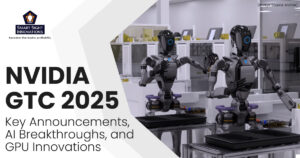
In a world where technology is rapidly advancing, one of the most profound impacts is being felt in the realm of accessibility. Robotics, with its ability to enhance mobility, assist in daily tasks, and provide sensory aids, is revolutionizing the lives of millions. From assistive robots that enhance mobility to AI-powered devices that amplify communication, innovation is empowering people with disabilities to live more independently and fully.
The Role of Robotics in Accessibility

Robotics is revolutionizing accessibility by breaking down barriers for millions of individuals with disabilities. With advancements in assistive technologies, robots are enabling greater independence, mobility, and participation in everyday life.
From robotic arms like Kinova’s JACO that assist with household tasks to exoskeletons such as SuitX’s Phoenix that restore mobility, these innovations empower users to reclaim autonomy. Embodied AI further enhances these systems, allowing robots to learn and adapt to individual needs.
In workplaces, collaborative robots are fostering inclusivity by assisting people with disabilities in performing physically demanding tasks. By addressing these barriers through thoughtful design and innovation, robotics holds immense potential to transform accessibility, creating a more inclusive world where technology uplifts everyone.
The Growing Need for Assistive Technology

The demand for assistive technology is growing rapidly, driven by demographic and health trends. With the global assistive technology market projected to reach $36.6 billion by 2033, factors like an aging population, rising prevalence of chronic diseases, and increasing disability rates are fueling this growth.
An estimated 1.3 billion people, or 16% of the global population, live with significant disabilities, a number that continues to rise. These challenges underscore the urgent demand for innovative solutions like assistive technologies and robotics to enhance accessibility.
Despite progress in disability inclusion, gaps remain in addressing systemic inequities and ensuring affordable solutions, highlighting the need for global collaboration to create a more inclusive society.
Innovations in robotics, AI, and wearable technology are making these solutions more effective and user-friendly. However, affordability and accessibility remain challenges, particularly in low-income regions, emphasizing the need for scalable and inclusive solutions to meet global demand.
Robotic Exoskeletons

AI-driven simulations are significantly enhancing the performance of robotic exoskeletons by optimizing their functionality and usability. Researchers have developed a machine-learning framework that bridges the gap between simulation and real-world application, enabling exoskeletons to autonomously assist users in activities like walking, running, and climbing stairs. These simulations allow exoskeletons to learn how to apply the right amount of force at the right time without requiring extensive human training sessions.
For example, trials showed that users consumed 24.3% less energy while walking with an exoskeleton trained through AI simulations compared to walking without it. Similarly, energy savings of 13.1% were achieved during running and 15.4% during stair climbing. This approach also eliminates the need for prolonged human testing, accelerating development and adoption.
Robotic exoskeletons are increasingly being integrated into daily life across various sectors, enhancing mobility, strength, and independence for users. Here are key areas where they are making an impact:
-
Medical Rehabilitation
Exoskeletons like ReWalk and EksoNR are widely used in rehabilitation centers to assist individuals with spinal cord injuries, strokes, or neurological conditions. These devices help patients regain mobility by enabling them to stand, walk, and perform daily activities independently. They also improve physical activity levels, reducing the health risks associated with prolonged sitting.
-
Workplace Applications
In industrial settings, exoskeletons are used to reduce physical strain during repetitive or heavy tasks. Devices like mechanical vests support workers in factories and warehouses by alleviating the burden of lifting and improving posture, thus preventing injuries.
-
Military and Emergency Services
Military-grade exoskeletons like Lockheed Martin’s Onyx enhance soldiers’ endurance by reducing physical loads during demanding tasks. Similarly, firefighters use these devices to carry heavy equipment or navigate challenging environments.
-
Physical Training for Athletes
Robotic exoskeletons enhance physical training for athletes by improving performance, reducing energy expenditure, and optimizing biomechanics. Devices like ankle exoskeletons developed at Stanford University have been shown to decrease the energy cost of running by up to 15%, allowing athletes to train longer and more efficiently.
Through customization and training, these devices adapt to an athlete’s specific needs, improving gait mechanics and reducing the risk of injury. Additionally, exoskeletons simulate resistance or support during movement, enabling targeted muscle development and rehabilitation, making them a powerful tool for enhancing athletic performance.
-
Pediatric
Pediatric exoskeletons have seen remarkable advancements, improving mobility and rehabilitation outcomes for children with neuromuscular conditions. The ATLAS2030, designed for children with cerebral palsy (CP) or spinal muscular atrophy (SMA), enables gait training, reduces spasticity, and enhances strength and range of motion.
It adapts to individual needs with intelligent joints and is wearable for real-world use. Innovations like soft knee exoskeletons also support early motor development by mimicking natural walking patterns. These devices are becoming more lightweight, customizable, and accessible, offering children greater independence and improved quality of life.
With advancements in AI and sensor technology, robotic exoskeletons continue to evolve, making them more accessible and effective in diverse environments.
Smart Wheelchairs

Smart wheelchairs are transforming mobility for people with disabilities, combining advanced sensors, AI, and IoT technology to enhance independence and safety. These wheelchairs can navigate obstacles, follow voice commands, and even detect changes in terrain for a smoother ride.
Some models offer health monitoring features, tracking vital signs and alerting caregivers to potential issues. With smartphone integration, users can control their wheelchair remotely or set automatic routes. By blending innovation with accessibility, smart wheelchairs are empowering individuals to live more freely and navigate the world with confidence.
Lokomat for Physical Therapy

The Lokomat is a cutting-edge robotic device used in physical therapy to enhance gait rehabilitation. It provides intensive, repetitive training to improve muscle strength and joint mobility, crucial for regaining walking ability. The Lokomat supports patients’ body weight, allowing them to walk on a treadmill while robotic parts move their legs through a natural gait cycle.
This technology reduces physical strain on therapists and offers precise control over training parameters, such as speed and stride length. The integration of virtual reality and augmented performance feedback motivates patients through engaging exercises, enhancing therapy outcomes. Studies have shown that Lokomat therapy improves walking function in individuals with neurological conditions like stroke and spinal cord injuries, offering a more effective alternative to traditional manual therapy methods.
Surgical-Assist Da Vinci

Surgical-assist systems like the Da Vinci Robotic Surgical System have revolutionized minimally invasive surgery, offering unparalleled precision and dexterity. This technology enhances surgeons’ capabilities by providing high-definition 3D visualization and robotic arms with a wider range of motion than human hands.
The Da Vinci system facilitates complex procedures through small incisions, reducing blood loss, postoperative pain, and scarring. Patients benefit from shorter hospital stays and faster recovery times, allowing them to return to normal activities sooner. Surgeons appreciate the ergonomic design, which reduces fatigue and improves control during procedures.
The system is versatile, supporting a wide range of specialties, including urology, gynecology, and cardiothoracic surgery. Overall, the Da Vinci system improves surgical outcomes by minimizing tissue damage and promoting faster healing, making it a preferred choice for both surgeons and patients.
Phoenix, a Powered and Lightweight Exoskeleton

(Image Source: SuitX)
The Phoenix exoskeleton, developed by SuitX, is a lightweight and modular device designed to assist individuals with mobility disorders. Weighing only 27 lbs, it is one of the lightest exoskeletons available, offering greater agility and ease of use.
The Phoenix consists of a hip module and two leg modules, allowing users to independently put on and remove each piece. It provides support and mobility, enabling users to stand, walk, and interact at eye level.
The exoskeleton is adjustable to fit different user sizes and can be configured for individual conditions. On a single charge, it supports continuous walking for up to 4 hours or intermittent use for 8 hours, with a maximum walking speed of 1.1 miles per hour.
Pepper, Providing Companionship and Social Interaction

(Image Source: Softbank Robotics)
Pepper, a humanoid robot by SoftBank Robotics, provides companionship and enhances social interaction through its advanced emotional intelligence and interactive capabilities. It recognizes facial expressions and voice emotions, responding with empathy and support.
Pepper engages in natural conversations, offering personalized interactions that adapt to users’ needs. Its ability to understand and respond to emotions makes Pepper a valuable companion for individuals seeking social interaction, fostering inclusivity and accessibility across various environments.
Assistive Robotics in Daily Tasks

Assistive robotics is revolutionizing daily life by providing support in various tasks, enhancing independence and quality of life for individuals with disabilities. Here are some examples of how assistive robots are aiding in daily chores:
-
Robotic Arms for Household Chores
Robotic arms, like Kinova’s JACO, are revolutionizing independence for people with limited mobility. Designed to mount on wheelchairs or stationary bases, JACO features a sleek, multi-jointed design that mimics human arm movement. It can grip, lift, and manipulate objects with precision, making tasks like opening doors, pouring drinks, or picking up items more manageable.
Controlled through a joystick, head array, or voice commands, JACO empowers users to perform everyday chores without assistance. This kind of technology doesn’t just enhance functionality; it restores freedom and confidence. As assistive robotics advance, devices like JACO pave the way for a more inclusive future.
-
Smart Mobility Devices
Smart mobility devices, like WHILL’s autonomous airport wheelchairs and robotic suitcases, are redefining travel accessibility. WHILL’s wheelchairs use sensors and AI to navigate busy terminals, safely transporting passengers to their gates without assistance.
They enhance independence, reduce stress, and make air travel more inclusive. Meanwhile, smart suitcases equipped with obstacle detection and follow-me technology trail behind users, eliminating the need to carry heavy bags.
These innovations break down physical barriers, making public spaces and travel experiences more accessible and seamless. As smart tech evolves, these devices promise to empower people with mobility challenges to explore the world with confidence.
These assistive robots not only enhance daily living but also contribute to a more inclusive and supportive environment for individuals with disabilities.
Advancements in Prosthetics and Augmentation

Recent innovations in prosthetics and augmentation are redefining the boundaries of human capability, with devices like Dani Clode’s Third Thumb leading the way. This wearable 3D-printed robotic thumb, is worn on the opposite side of the palm from the natural thumb and is controlled by pressure sensors under the big toes.
It allows users to perform tasks that would typically require two hands, such as carrying multiple objects simultaneously or playing complex chords on the guitar. Key Improvements in Grasping Capabilities:
-
Increased Dexterity
The Third Thumb offers enhanced hand functionality, enabling users to manipulate objects more efficiently. It can grasp and hold items independently, freeing the biological hand for other tasks.
-
Expanded Carrying Capacity
Users can carry more objects at once, improving productivity and reducing the need for additional support.
-
Quick Adaptation
Studies show that nearly 98% of participants can use the Third Thumb effectively within the first minute, demonstrating its intuitive design and ease of use.
Overall, the Third Thumb revolutionizes hand functionality by augmenting natural capabilities, making it a powerful tool for both individuals with disabilities and those seeking enhanced productivity
Wearable Robotics

Wearable robotics, including devices like wearable hands, are revolutionizing daily life by enhancing mobility, strength, and independence for individuals with disabilities. Here are some examples and trends in this field:
-
Prosthetic Hands
Advanced prosthetic hands, such as those developed by DEKA Research and Development, offer precise control and dexterity, allowing users to perform complex tasks like cooking or playing musical instruments.
-
Assistive Gloves
Devices like the Soft Robotic Glove assist individuals with hand impairments by providing grip support and enhancing hand function, enabling tasks such as holding objects or using tools.
Wearable robots are becoming more intelligent and adaptive, integrating AI and IoT to enhance user experience and safety. This technology allows devices to learn user preferences and adjust accordingly. Efforts are underway to make wearable assistive technology more affordable and accessible globally. Initiatives like the Global Cooperation on Assistive Technology (GATE) aim to improve access to these devices for millions worldwide.
Future wearable robots will likely incorporate advanced materials and designs, offering greater comfort, durability, and customization. These innovations will further enhance the quality of life for users by providing seamless integration with the human body. Overall, wearable robotics is poised to continue transforming lives by offering enhanced mobility, independence, and quality of life for individuals with disabilities and impairments.
Robotics for Sensory Impairments

Robotics is playing a crucial role in addressing sensory impairments by developing innovative devices that assist individuals with visual or auditory disabilities. Here are some examples of how robotics is enhancing accessibility for those with sensory impairments:
-
Sign Language Robots
Robots are being developed to translate text into sign language, facilitating communication between hearing and non-hearing individuals. These robots use cameras and AI to interpret and generate sign language in real-time, making public services, education, and workplaces more inclusive.
-
Smart Canes and Wearable Devices
Innovations like smart canes equipped with sensors and GPS help visually impaired individuals navigate through spaces more safely. These devices provide real-time feedback about obstacles and surroundings, enhancing mobility and independence.
-
Robotic Guides
Robots designed to assist visually impaired individuals can detect and avoid obstacles, providing tactile feedback to guide users through complex environments. These robots often integrate AI to learn user preferences and adapt to new settings.
As robotics continues to evolve, we can expect more sophisticated devices that integrate multiple sensory modalities to assist individuals with sensory impairments. Additionally, advancements in AI will enable these devices to learn and adapt to individual needs more effectively, offering personalized assistance and support.














